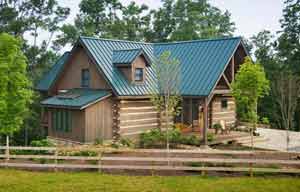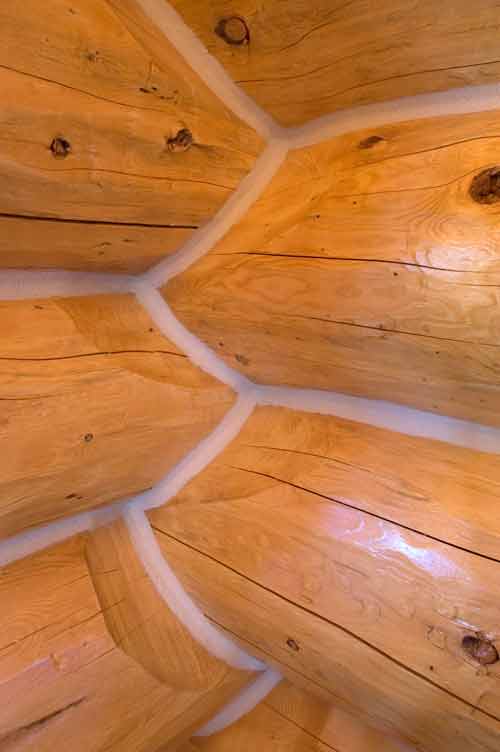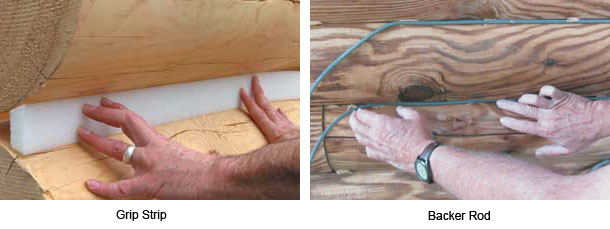What is the Purpose of Chinking?
 Since its invention in 1981, Perma-Chink log home sealant has been the leader in making log homes comfortable, weather tight and energy efficient. Millions of homes around the world are sealed with the first sealant that looks like traditional concrete mortar, but stretches and moves with seasonal log movement to ensure a tight seal to eliminate air and water infiltration or infestation by insects.
Since its invention in 1981, Perma-Chink log home sealant has been the leader in making log homes comfortable, weather tight and energy efficient. Millions of homes around the world are sealed with the first sealant that looks like traditional concrete mortar, but stretches and moves with seasonal log movement to ensure a tight seal to eliminate air and water infiltration or infestation by insects.
Remember, having 1/16" voids (between the horizontal logs and corners) and unsealed gaps where the logs terminate up against the window and doorjambs can be no different than having a window open on a breezy, bitter cold December evening.
The Product
 Perma-Chink Systems revolutionized the log home weatherization process in the early 80's with our elastomeric, flexible chinking which emulates traditional mortar. With a strong presence from Alaska to New Zealand, it is proven to be the most effective, permanent sealant to any climate.
Perma-Chink Systems revolutionized the log home weatherization process in the early 80's with our elastomeric, flexible chinking which emulates traditional mortar. With a strong presence from Alaska to New Zealand, it is proven to be the most effective, permanent sealant to any climate.
How Long Will it Take to Apply Log Home Chinking?
How long the process will take you depends on the amount of lineal footage you have to seal, what percentage of chinking is done while on a ladder, method of application, how precisely the logs fit together, whether you do the log extensions or vertical corners, how wide the joint is, whether you do the joint at the diagonal roofline, how many hours you work in a day, the inconvenience of working around shrubs, trees and other natural structures. But the most definitive factor deciding how long your project will take may depend on the look you want.
Removal of Failed Chinking
Keep in mind: old, unsightly, failed chinking does not always need to be removed before applying Perma-Chink. Applying Perma-Chink over existing chinking can be done, but make sure the new chink joint is wider than the existing, allowing for adhesion to clean wood.
When dealing with old mortar, any loose pieces should be removed and the void filled with backing rod. If old mortar is taken out completely, make sure to sand or wash the portion of the log where the new Perma-Chink sealant will be in contact. Depending on the adhesion of the mortar, and whether or not it is held in place with wire or nails, the removal process can be much more time consuming than the application of Perma-Chink. Keep in mind; it is generally easier, neater and quicker to apply Perma-Chink over foam Backing Rod than over existing textured mortar.
The Right Tools
The method of application can vary tremendously depending on personal preference, the financial commitment you are making to the project and the size of the project. Read more about our tools here https://www.permachink.com/pcs-connections/tools-and-tooling-your-sealants
Backing Rod
 There are three primary functions of the round foam Backing Rod that are tucked into place on to which the Perma-Chink (or Energy Seal) is applied. First, it allows the applicator to form a two-point adhesion (on the top and bottom log), which provides for better elasticity during inevitable log- movement. Second, backing rods allow you to apply a uniform thickness, and third, it saves you money by not using more chinking than you need to. When filling up a joint without utilizing Backing Rod, you can easily use twice as much chinking as necessary. It is available on rolls ranging from 1 foot to 6,400 feet, depending on the size needed. Sizes available range from 1/4" up to 2" of the round Backer Rod. Grip Strip, which provides the same function, is trapezoid shaped, allow you to chink over a flat surface, if desired. These sizes range from 3/4" to 6" wide.
There are three primary functions of the round foam Backing Rod that are tucked into place on to which the Perma-Chink (or Energy Seal) is applied. First, it allows the applicator to form a two-point adhesion (on the top and bottom log), which provides for better elasticity during inevitable log- movement. Second, backing rods allow you to apply a uniform thickness, and third, it saves you money by not using more chinking than you need to. When filling up a joint without utilizing Backing Rod, you can easily use twice as much chinking as necessary. It is available on rolls ranging from 1 foot to 6,400 feet, depending on the size needed. Sizes available range from 1/4" up to 2" of the round Backer Rod. Grip Strip, which provides the same function, is trapezoid shaped, allow you to chink over a flat surface, if desired. These sizes range from 3/4" to 6" wide.
Simple Clean Up
While Perma-Chink will not come out of clothes and sticks tenaciously to clean wood once cured, cleaning your tools at the end of the day is quite easy with the use of water. Generally, soap is not even needed, unless it is dried a bit in which case a little scrubbing will help.
